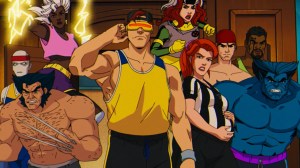Many of the best new concepts in comics are pitched as a remix. Saga is constantly referred to as a combination of Star Wars and Romeo & Juliet. Anyone that reads the series knows that this is a quick tagline for something that is far better than a Frankenstein’s monster of prior plots. The recognition of the familiar isn’t as valuable as crafting something new from those elements. It’s this weaving of familiar beats and rhythms that make Mech Cadet Yu stand out as a great new series. Readers might pick up strains of Gundam, Power Rangers, or, even, Wonder. Yet in the course of its first collection Mech Cadet Yu establishes that it’s its own thing, and something worth our attention.
Videos by ComicBook.com
The first collection of Mech Cadet Yu, a direct market exclusive, collects the first four issues of the new BOOM! Studios series. It launches alongside the fifth issue as well, providing new readers a perfect jumping on point. While that may not sound like much, the first four issues of the series provide just the right amount of time for the story to get its bearings and an introduction that removes any future need for exposition. When a reader finishes this collection, they know what Mech Cadet Yu is about and just how much they want to keep reading.

This introduction focuses on Stanford Yu, a young janitor who services Sky Corp Academy, a training facility for elite cadets preparing to pilot alien mechs. The school was established by the very first mech pilot for future arrivals needed to defend the Earth against the Sharg, an alien menace. Yu is bullied by the other students, who have benefited from the best schooling and parents with standing, until one of the new mech arrivals selects him. Thus begins an adventure into both the exciting world of mechs in the military and breaking into an elitist institution not prepared to accept Yu.
The largest hurdle throughout the course of the first volume lies in the worldbuilding necessary for characters and themes to click into place. While there are familiar tropes from the mech genre, the manner in which pilots find their companions and train with them are both unique. By the conclusion of this collection that novelty is a strength that clearly reinforces what Mech Cadet Yu is about. However, at the start of the story, it poses issues due to a lack of consistency and clarity.
Much of this comes from a disconnect between art and explanation. It is stated that only three mechs arrive each year, but the school appears to be massive, and all of the students appear to be training for the same job. Every new fact about the world raises questions, curiosity proving the potential strength of the concept, but what is on the page often fails to offer answers. While one or two discrepancies could be discarded easily as nitpicks, the first half of the story is filled with enough odd details that it pulls away from the narrative in which writer Greg Pak appears much more interested.

For whatever early disconnects there may be between the world described in dialogue and the world on the page, it’s the world on the page that carries Mech Cadet Yu and makes these issues easier to ignore. Artist Takeshi Miyazawa populates panels with mechs and monsters alike that don’t feel like specific takes on any prior story or even specific subset of the genre. What is on the page is something specific to this comic and manages to deliver plenty of reasons to seek it out.
The mechs play a fascinating role within the art, as they are required to be living, empathetic beings incapable of expression or speech. The design of each of the four new mechs utilized by the cadets goes a long way in overcoming this problem. There are connections to be found between the cadets and the mechs as well. Yu’s is the smallest of the lot and contains elements that make it seem like a child’s toy. This mech, named Buddy, is innocent in all of the ways that name implies, like a Golden Retriever. Staging and color do the rest, especially with the eyes of the mechs as they change in response to stimuli. Given how well a robot is capable of bringing charm and joy into a panel, it’s no surprise the humans of the story are active and expressive. Gestures and expressions are never exaggerated and carry a genuine warmth within each small moment.
Miyazawa’s monsters are every bit as important in bringing the concept together when the Sharg are finally introduced. The clean lines and clear designs are interrupted by something more primal in the shelled behemoths. They are filthy and natural, but only natural in the way that the shark in Jaws might be. There’s something inhuman in their biology and it makes the little space they appear hold plenty of impact. Miyazawa utilizes splashes to convey scale as well as to clarify action with many individuals. They build excitement and encourage lingering, stretching out action sequences that last less than a dozen pages.

The natural humanity within Miyazawa’s work builds character and team dynamics so naturally that when the big moments begin to land, they do so in a surprisingly stealthy fashion. Yu’s fight with his mother, a betrayal during training, and, of course, the big action set piece all hit home because of the people involved. This is the point where Pak and Miyazawa’s focus and strengths collide and transform Mech Cadet Yu into a roller coaster of a read, funny and moving by equal turns, in its second half.
Yu and his interactions with teammates and mentors, both positive and negative, dig into themes of merit, discrimination, and talent. While the ideas are clear, they are not preached. Instead, they flow naturally from Yu and his relationships. No one is an obvious hero or villain in the pages of Mech Cadet Yu, and it’s easy to find yourself like a bully. There’s an earnestness to the cadets that allows these ideas to be familiar and reassuring, the way that a good all ages story ought to be. Even if some of the core characters still lack depth, the focus on Yu is what pulls the introduction together and provides a satisfying conclusion to a first chapter.
Much like Buddy, Mech Cadet Yu starts with an imperfect landing and a few pieces out of place. Yet the benefit of a complete first volume reveals these imperfections to be superficial dings. The mechanics of the story are all well-assembled and take flight by the final pages. When taken together the first four issues make for an irresistible read, one that is impossible to set down during a single setting. The charm of robots and humans alike, combined with a strong heart set in the absolutely right place, make Mech Cadet Yu one new comic that will hopefully last a very long time.
Grade: B
Written by Greg Pak
Art by Takeshi Miyazawa
Colors by Triona Farrell





